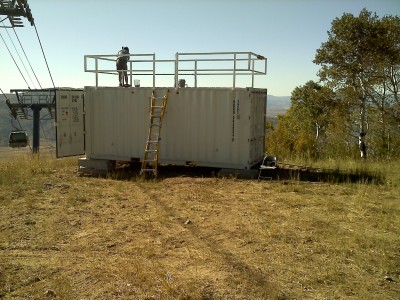Tuesday, September 28
Published: 30 September 2010
Another good day at the valley site. The telescoping tower was tipped down to check on the PSP and PIR, which were giving some strange readings. We weren’t too worried as we had not yet updated the coefficients and serial numbers in the datalogger program. Once we changed those to the proper values, errors were still occurring. After a few tests it turned out that the GRNDRAD IRT had failed. Some sort of internal short.
It is possible that the IRT had damage from the R/V Connecticut deployment as the one that failed had been on that trip. We will have to ask the manufacturer for information on the cause of failure. We rinsed all the sensors and equipment thoroughly (or so we thought) after we pulled back into port. However, we noticed during the cruise that the IRTs and some other sensors were too low and were taking quite a bit of salt spray.
Once the error was found, the IRT was removed and the GNDRAD PIR and PSP came back online. Mike Turner and Mike Ritsche (Mikes^2) spent the rest of the day updating calibration coefficients, setting up the LoggerNet system, scripts and displays for the GNDRAD, MET, SKYRAD, SPN and MFRSR. Mike Ritsche went to the hardware store to purchase items for sealing the cable penetrations into the various containers and white paint for the plywood.
We are planning to cut plywood to set on top of some of the modules. This way they don’t stand out to some of the downward looking radiometers. Right now, the local plant life is various shades of brown, and with tan-colored soil the SS modules stand out. We have moved the modules as far as possible away from sensors, but some cabling requires us to be within the sensor field of view. Once snow flies, we will paint the plywood white so the modules blend in with their surroundings.
There are a few loose ends to tie up at the Thunderhead and Christie Peak sites. There is some thought of extending the stay for a few ANL folks to ensure a smooth transition from deployment to operations. It’s been a productive yet hurried couple weeks for the AMF2 support staff.

The ARM Climate Research Facility is a DOE Office of Science user facility. The ARM Facility is operated by nine DOE national laboratories, including .
Keep up with the Atmospheric Observer
Updates on ARM news, events, and opportunities delivered to your inbox
ARM User Profile
ARM welcomes users from all institutions and nations. A free ARM user account is needed to access ARM data.


















